1996 NISSAN QUEST transmission
[x] Cancel search: transmissionPage 206 of 235
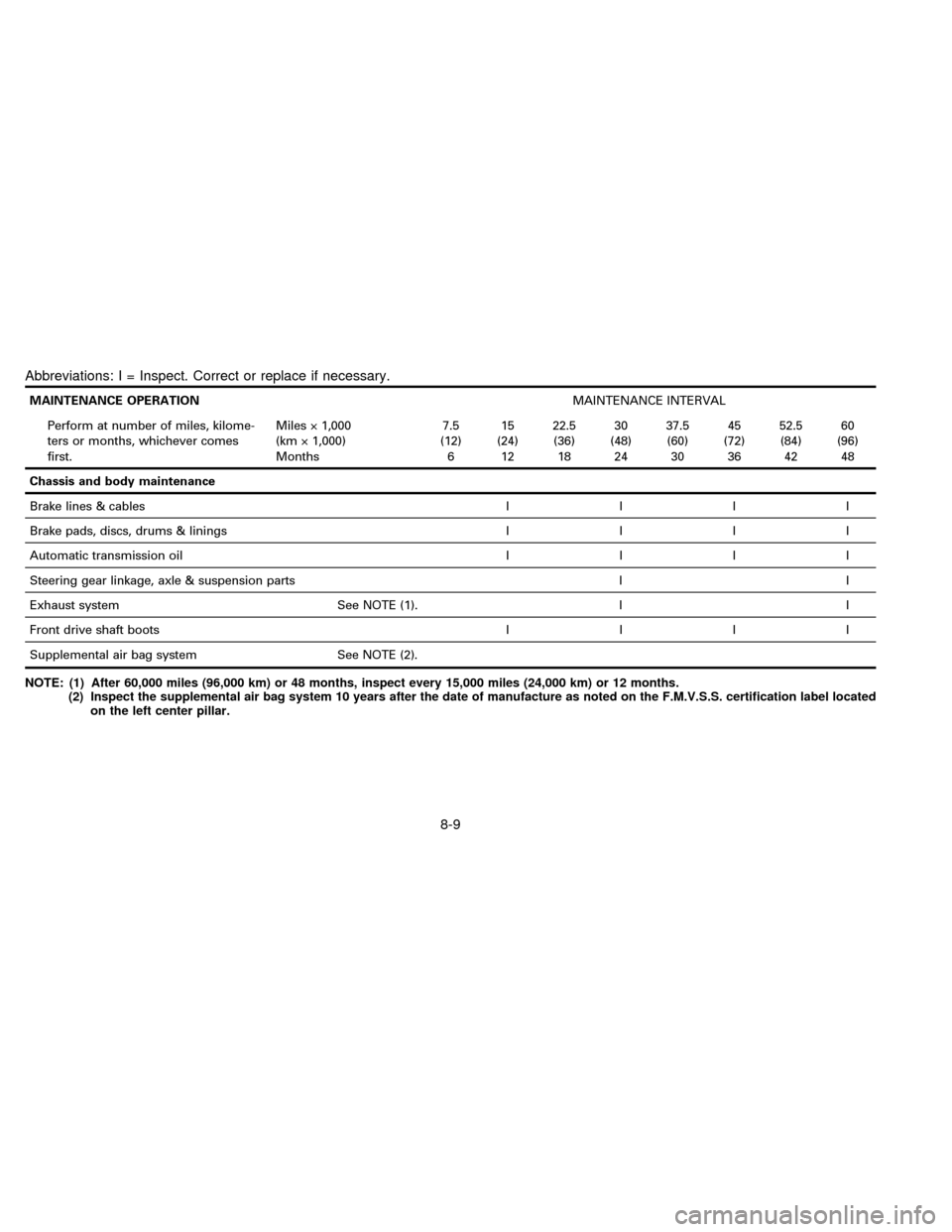
Abbreviations: I = Inspect. Correct or replace if necessary.
MAINTENANCE OPERATIONMAINTENANCE INTERVAL
Perform at number of miles, kilome-
ters or months, whichever comes
first.Miles ý 1,000
(km ý 1,000)
Months7.5
(12)
615
(24)
1222.5
(36)
1830
(48)
2437.5
(60)
3045
(72)
3652.5
(84)
4260
(96)
48
Chassis and body maintenance
Brake lines & cablesIIII
Brake pads, discs, drums & liningsIIII
Automatic transmission oilIIII
Steering gear linkage, axle & suspension parts I I
Exhaust system See NOTE (1). I I
Front drive shaft bootsIIII
Supplemental air bag system See NOTE (2).
NOTE: (1) After 60,000 miles (96,000 km) or 48 months, inspect every 15,000 miles (24,000 km) or 12 months.
(2) Inspect the supplemental air bag system 10 years after the date of manufacture as noted on the F.M.V.S.S. certification label located
on the left center pillar.
8-9
ZX
Page 207 of 235

EXPLANATION OF
MAINTENANCE ITEMS
Additional information on the following
items with ``*'' is found in the ``Do-it-
yourself operations'' section.
Emission control system mainte-
nance
Drive belts* ÐCheck drive belts for wear,
fraying or cracking and also for proper ten-
sion. Replace the drive belts if found dam-
aged.
Air cleaner filter ÐUnder normal driving
conditions, the air cleaner filter should be
replaced in accordance with the mainte-
nance schedule. However, driving the ve-
hicle in dusty areas may cause more rapid
clogging of the element. Consequently, the
element may have to be replaced more
frequently.
Vapor lines ÐCheck vapor lines and con-
nections for failure or looseness. If leaks are
found, replace them.
Fuel lines ÐCheck the fuel hoses, piping
and connections for leaks, looseness or
deterioration. Replace any parts if they are
damaged.Fuel filter ÐIf the vehicle is operated
under extremely adverse weather condi-
tions or in areas where ambient tempera-
tures are either extremely low or extremely
high, the filter might become clogged. In
such an event, replace the filter immedi-
ately.
Engine coolant* ÐChanging engine cool-
ant can be performed by your NISSAN
dealer or procedures can be found in the
Service Manual. Improper air relief after
changing coolant can result in reduced
heater performance and overheating.
Engine oil & oil filter* ÐUnder normal
driving conditions, the engine oil and oil filter
should be replaced in accordance with the
maintenance schedule. However, under se-
vere driving conditions, they may have to be
replaced more frequently.
Spark plugs* ÐReplace with new plugs
having the correct heat range.
Timing belt ÐReplace the timing belt for
driving the camshaft.
Chassis and body maintenance
Brake lines & cables ÐCheck the brake
lines and hoses (including brake boostervacuum hoses, connections & check valve)
and parking brake cables for proper attach-
ment, leaks, cracks, chafing, abrasion, de-
terioration, etc.
Brake pads, discs, drums & linings Ð
Check these and the other neighboring
brake components for wear, deterioration
and leaks. Under severe driving conditions,
they may have to be inspected more fre-
quently.
Automatic transmission fluid* ÐCheck
the fluid level and visually inspect for signs
of leakage.
Under severe driving conditions, the fluid
should be replaced at the specified interval.
Steering gear & linkage, axle & suspen-
sion parts, and drive shaft boots Ð
Check for damage, looseness and leakage
of oil or grease. Under severe driving con-
ditions, more frequent inspection should be
performed.
Steering linkage ball joints & front sus-
pension ball joints ÐCheck the ball joints
for damage, looseness and grease leakage.
8-10
ZX
Page 211 of 235
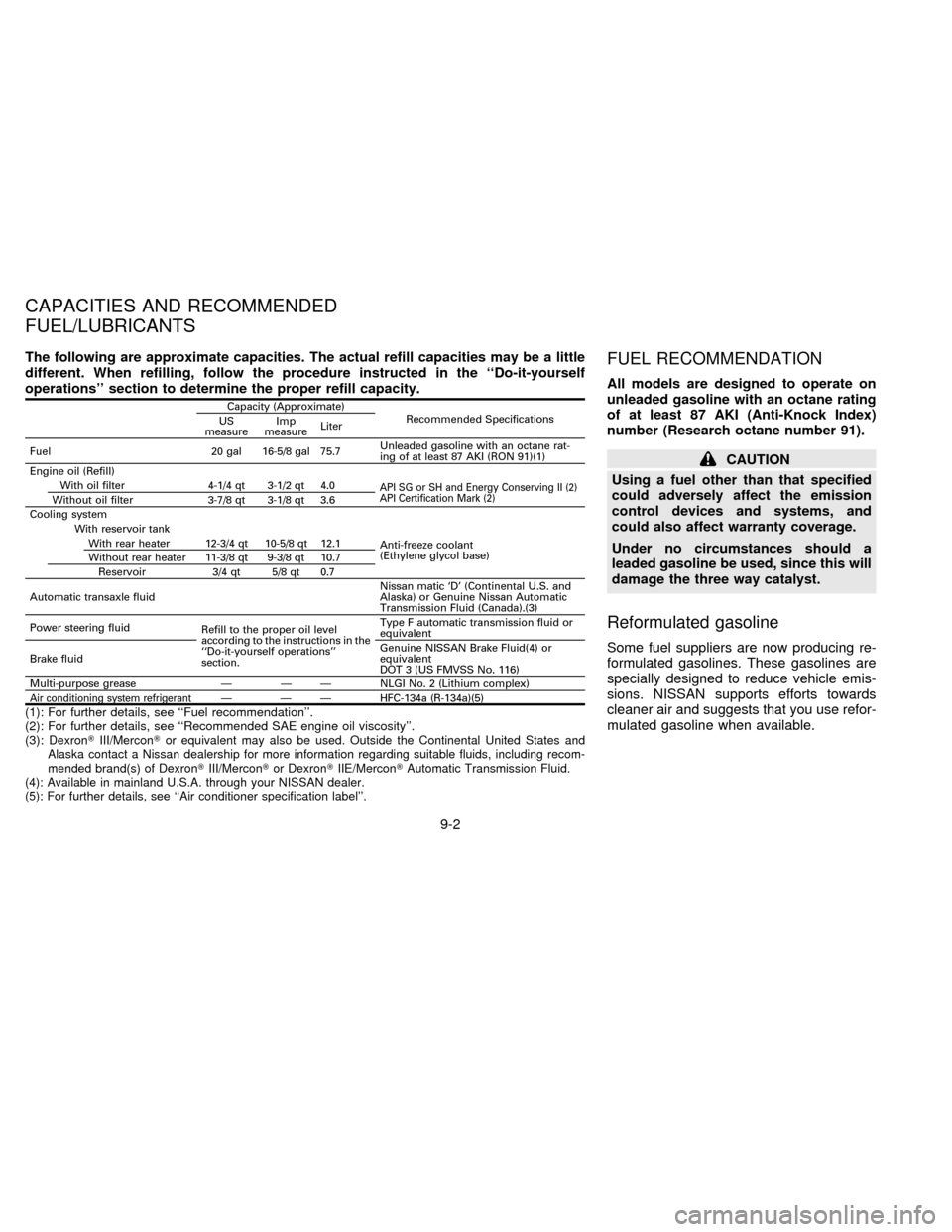
The following are approximate capacities. The actual refill capacities may be a little
different. When refilling, follow the procedure instructed in the ``Do-it-yourself
operations'' section to determine the proper refill capacity.
Capacity (Approximate)
Recommended Specifications
US
measureImp
measureLiter
Fuel 20 gal 16-5/8 gal 75.7Unleaded gasoline with an octane rat-
ing of at least 87 AKI (RON 91)(1)
Engine oil (Refill)
With oil filter 4-1/4 qt 3-1/2 qt 4.0
API SG or SH and Energy Conserving II (2)
API Certification Mark (2)Without oil filter 3-7/8 qt 3-1/8 qt 3.6
Cooling system
With reservoir tank
With rear heater 12-3/4 qt 10-5/8 qt 12.1
Anti-freeze coolant
(Ethylene glycol base)
Without rear heater 11-3/8 qt 9-3/8 qt 10.7
Reservoir 3/4 qt 5/8 qt 0.7
Automatic transaxle fluidNissan matic `D' (Continental U.S. and
Alaska) or Genuine Nissan Automatic
Transmission Fluid (Canada).(3)
Power steering fluid
Refill to the proper oil level
according to the instructions in the
``Do-it-yourself operations''
section.Type F automatic transmission fluid or
equivalent
Brake fluidGenuine NISSAN Brake Fluid(4) or
equivalent
DOT 3 (US FMVSS No. 116)
Multi-purpose grease Ð Ð Ð NLGI No. 2 (Lithium complex)
Air conditioning system refrigerantÐ Ð Ð HFC-134a (R-134a)(5)(1): For further details, see ``Fuel recommendation''.
(2): For further details, see ``Recommended SAE engine oil viscosity''.
(3):
DexronTIII/MerconTor equivalent may also be used. Outside the Continental United States and
Alaska contact a Nissan dealership for more information regarding suitable fluids, including recom-
mended brand(s) of DexronTIII/MerconTor DexronTIIE/MerconTAutomatic Transmission Fluid.
(4): Available in mainland U.S.A. through your NISSAN dealer.
(5): For further details, see ``Air conditioner specification label''.
FUEL RECOMMENDATION
All models are designed to operate on
unleaded gasoline with an octane rating
of at least 87 AKI (Anti-Knock Index)
number (Research octane number 91).
CAUTION
Using a fuel other than that specified
could adversely affect the emission
control devices and systems, and
could also affect warranty coverage.
Under no circumstances should a
leaded gasoline be used, since this will
damage the three way catalyst.
Reformulated gasoline
Some fuel suppliers are now producing re-
formulated gasolines. These gasolines are
specially designed to reduce vehicle emis-
sions. NISSAN supports efforts towards
cleaner air and suggests that you use refor-
mulated gasoline when available.
CAPACITIES AND RECOMMENDED
FUEL/LUBRICANTS
9-2
ZX
Page 226 of 235
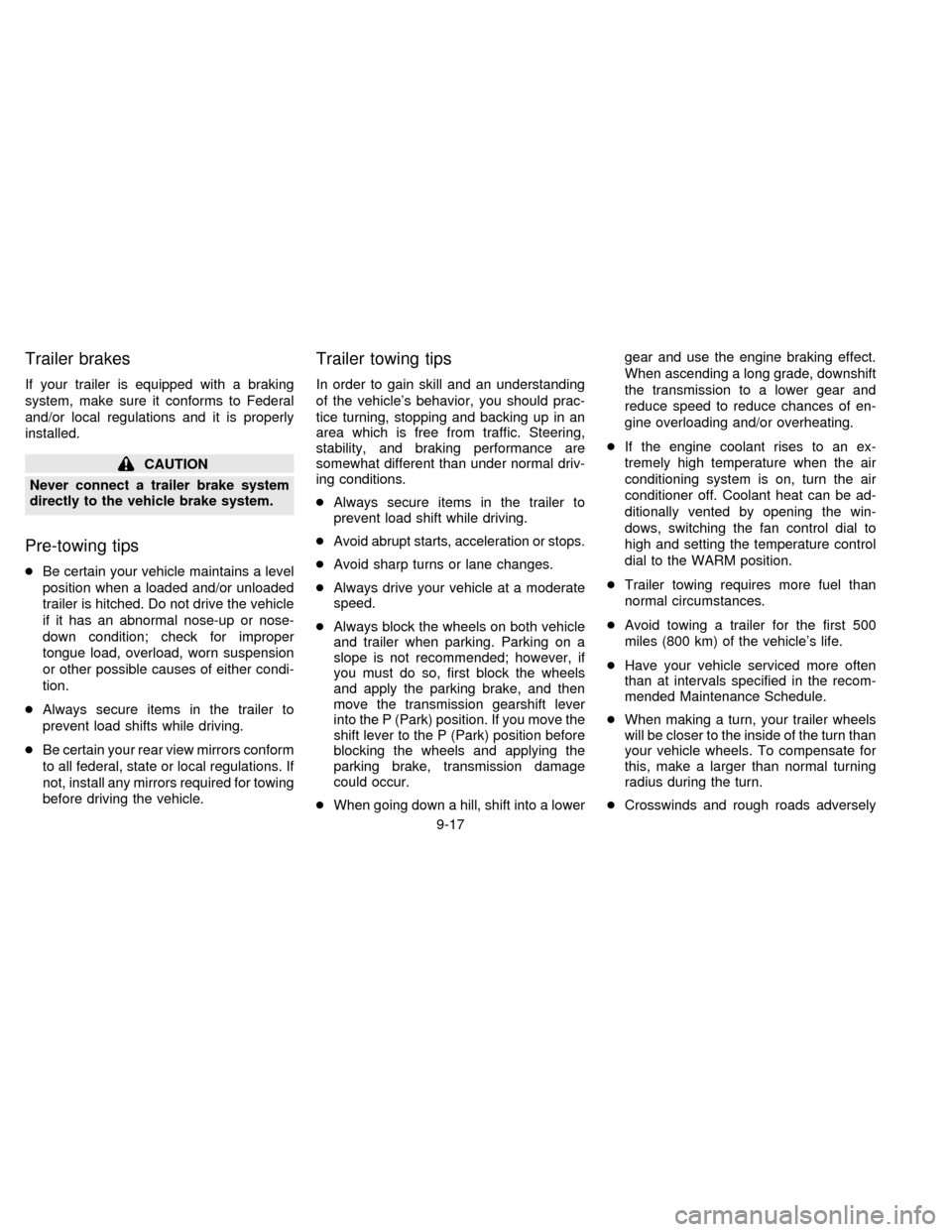
Trailer brakes
If your trailer is equipped with a braking
system, make sure it conforms to Federal
and/or local regulations and it is properly
installed.
CAUTION
Never connect a trailer brake system
directly to the vehicle brake system.
Pre-towing tips
cBe certain your vehicle maintains a level
position when a loaded and/or unloaded
trailer is hitched. Do not drive the vehicle
if it has an abnormal nose-up or nose-
down condition; check for improper
tongue load, overload, worn suspension
or other possible causes of either condi-
tion.
cAlways secure items in the trailer to
prevent load shifts while driving.
cBe certain your rear view mirrors conform
to all federal, state or local regulations. If
not, install any mirrors required for towing
before driving the vehicle.
Trailer towing tips
In order to gain skill and an understanding
of the vehicle's behavior, you should prac-
tice turning, stopping and backing up in an
area which is free from traffic. Steering,
stability, and braking performance are
somewhat different than under normal driv-
ing conditions.
cAlways secure items in the trailer to
prevent load shift while driving.
c
Avoid abrupt starts, acceleration or stops.
cAvoid sharp turns or lane changes.
cAlways drive your vehicle at a moderate
speed.
cAlways block the wheels on both vehicle
and trailer when parking. Parking on a
slope is not recommended; however, if
you must do so, first block the wheels
and apply the parking brake, and then
move the transmission gearshift lever
into the P (Park) position. If you move the
shift lever to the P (Park) position before
blocking the wheels and applying the
parking brake, transmission damage
could occur.
cWhen going down a hill, shift into a lowergear and use the engine braking effect.
When ascending a long grade, downshift
the transmission to a lower gear and
reduce speed to reduce chances of en-
gine overloading and/or overheating.
cIf the engine coolant rises to an ex-
tremely high temperature when the air
conditioning system is on, turn the air
conditioner off. Coolant heat can be ad-
ditionally vented by opening the win-
dows, switching the fan control dial to
high and setting the temperature control
dial to the WARM position.
cTrailer towing requires more fuel than
normal circumstances.
cAvoid towing a trailer for the first 500
miles (800 km) of the vehicle's life.
cHave your vehicle serviced more often
than at intervals specified in the recom-
mended Maintenance Schedule.
cWhen making a turn, your trailer wheels
will be closer to the inside of the turn than
your vehicle wheels. To compensate for
this, make a larger than normal turning
radius during the turn.
cCrosswinds and rough roads adversely
9-17
ZX
Page 227 of 235

affect vehicle/trailer handling, possibly
causing vehicle sway. When being
passed by larger vehicles, be prepared
for possible changes in crosswinds that
could affect vehicle handling. If swaying
does occur, firmly grip the steering
wheel, steer straight ahead, and immedi-
ately (but gradually) reduce vehicle
speed. This combination helps to stabi-
lize the vehicle. Never increase speed.
cBe careful when passing other vehicles.
Passing while towing a trailer requires
considerably more distance than normal
passing. Remember the length of the
trailer must also pass the other vehicle
before you can safely change lanes.
cTo maintain engine braking efficiency
and electrical charging performance, do
not use overdrive.
cAvoid holding the brake pedal down too
long or too frequently. This could cause
the brakes to overheat, resulting in re-
duced braking efficiency.
When towing a trailer, change fluid in the
transmission more frequently.
See the Maintenance schedule.Department of Transportation (DOT) Qual-
ity Grades: All passenger car tires must
conform to Federal Safety Requirements in
addition to these grades.
Treadwear
Treadwear grade is a comparative rating
based on tire wear rate when tested under
controlled conditions on specified govern-
ment test courses. For example, a tire
graded 150 would wear one and a half
(1-1/2) times as well on the government
course as a tire graded 100. However,
relative tire performance depends on actual
driving conditions, and may vary signifi-
cantly from the norm, due to variations in
driving habits, service practices and differ-
ences in road characteristics and climate.
Traction A, B and C
Traction grades are A (the highest), B and
C. They represent a tire's ability to stop on
wet pavement as measured under con-
trolled conditions, on specified government
test surfaces of asphalt and concrete. A tire
marked with a C may have poor traction
performance.
WARNING
The traction grade assigned to your
vehicle tires is based on straight line
braking traction tests and does not
include cornering (turning) traction.
Temperature A, B and C
Temperature grades are A (the highest), B,
and C. They represent a tire's resistance to
heat build-up, and its ability to dissipate
heat when tested under controlled condi-
tions on a specified indoor laboratory test
wheel. Sustained high temperature can
cause tire material to degenerate, reducing
tire life. Excessive temperatures can lead to
sudden tire failure. Grade C corresponds to
a performance level which all passenger car
tires must meet under the Federal Motor
Vehicle Safety Standard No. 109. Grades A
and B represent higher levels of perfor-
mance on laboratory test wheels than the
minimum required by law.
UNIFORM TIRE QUALITY
GRADING
9-18
ZX
Page 230 of 235
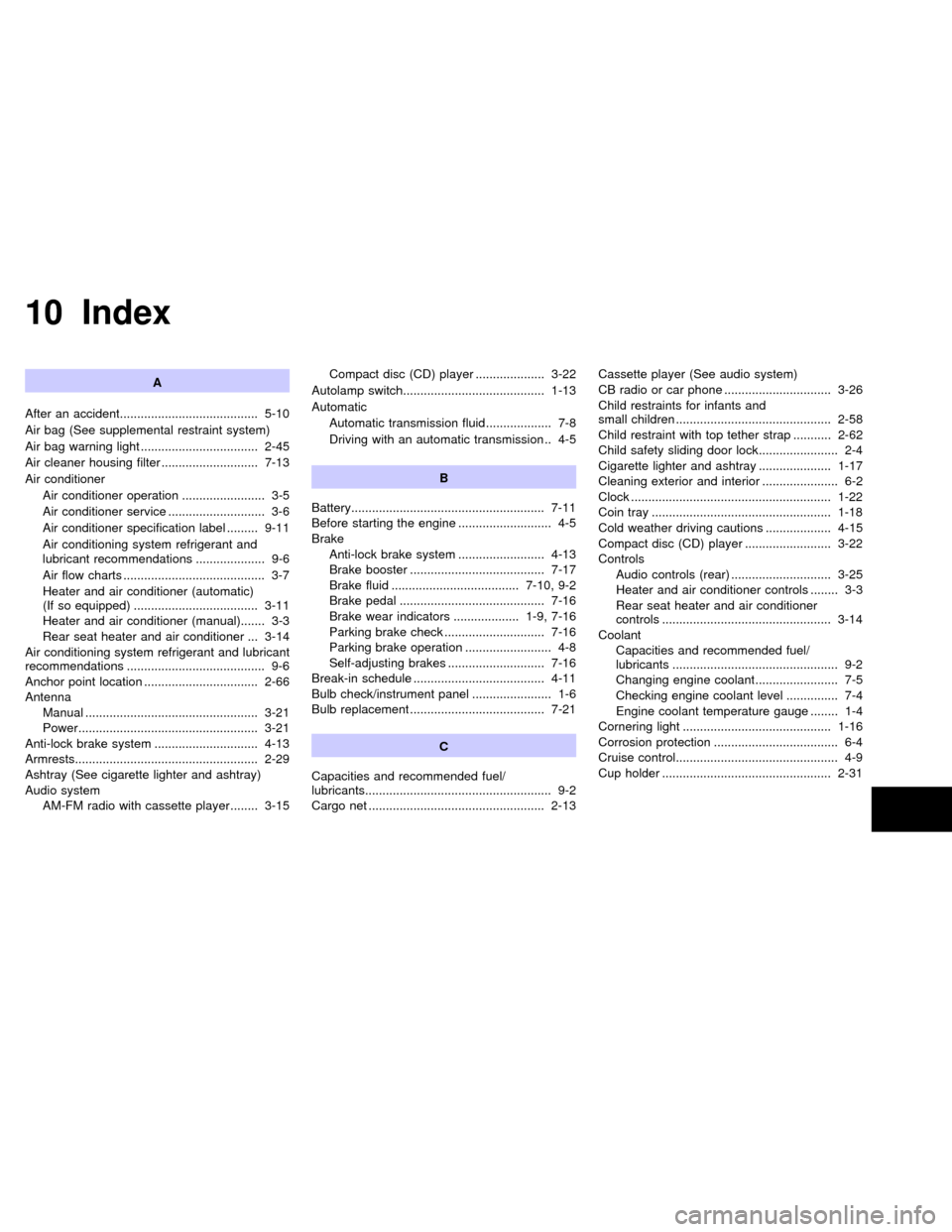
10 Index
A
After an accident........................................ 5-10
Air bag (See supplemental restraint system)
Air bag warning light .................................. 2-45
Air cleaner housing filter ............................ 7-13
Air conditioner
Air conditioner operation ........................ 3-5
Air conditioner service ............................ 3-6
Air conditioner specification label ......... 9-11
Air conditioning system refrigerant and
lubricant recommendations .................... 9-6
Air flow charts ......................................... 3-7
Heater and air conditioner (automatic)
(If so equipped) .................................... 3-11
Heater and air conditioner (manual)....... 3-3
Rear seat heater and air conditioner ... 3-14
Air conditioning system refrigerant and lubricant
recommendations ........................................ 9-6
Anchor point location ................................. 2-66
Antenna
Manual .................................................. 3-21
Power.................................................... 3-21
Anti-lock brake system .............................. 4-13
Armrests..................................................... 2-29
Ashtray (See cigarette lighter and ashtray)
Audio system
AM-FM radio with cassette player ........ 3-15Compact disc (CD) player .................... 3-22
Autolamp switch......................................... 1-13
Automatic
Automatic transmission fluid ................... 7-8
Driving with an automatic transmission .. 4-5
B
Battery........................................................ 7-11
Before starting the engine ........................... 4-5
Brake
Anti-lock brake system ......................... 4-13
Brake booster ....................................... 7-17
Brake fluid ..................................... 7-10, 9-2
Brake pedal .......................................... 7-16
Brake wear indicators ................... 1-9, 7-16
Parking brake check ............................. 7-16
Parking brake operation ......................... 4-8
Self-adjusting brakes ............................ 7-16
Break-in schedule ...................................... 4-11
Bulb check/instrument panel ....................... 1-6
Bulb replacement ....................................... 7-21
C
Capacities and recommended fuel/
lubricants...................................................... 9-2
Cargo net ................................................... 2-13Cassette player (See audio system)
CB radio or car phone ............................... 3-26
Child restraints for infants and
small children ............................................. 2-58
Child restraint with top tether strap ........... 2-62
Child safety sliding door lock....................... 2-4
Cigarette lighter and ashtray ..................... 1-17
Cleaning exterior and interior ...................... 6-2
Clock .......................................................... 1-22
Coin tray .................................................... 1-18
Cold weather driving cautions ................... 4-15
Compact disc (CD) player ......................... 3-22
Controls
Audio controls (rear) ............................. 3-25
Heater and air conditioner controls ........ 3-3
Rear seat heater and air conditioner
controls ................................................. 3-14
Coolant
Capacities and recommended fuel/
lubricants ................................................ 9-2
Changing engine coolant........................ 7-5
Checking engine coolant level ............... 7-4
Engine coolant temperature gauge ........ 1-4
Cornering light ........................................... 1-16
Corrosion protection .................................... 6-4
Cruise control............................................... 4-9
Cup holder ................................................. 2-31
ZX
Page 231 of 235

D
Daytime running light system (Canada
only) ........................................................... 1-13
Defogger switch
Rear window defogger switch .............. 1-12
Dimensions and weights.............................. 9-8
Door locks .................................................... 2-2
Drive belts .................................................. 7-12
Driving
Cold weather driving cautions .............. 4-15
Driving with an automatic transmission .. 4-5
Precautions when driving ..................... 4-13
Precautions when starting and driving ... 4-2
E
Economy - fuel........................................... 4-11
Emission control information label............. 9-10
Emission control system warranty ............. 9-19
Engine .......................................................... 9-7
Before starting the engine ...................... 4-5
Capacities and recommended fuel/
lubricants ................................................ 9-2
Changing engine coolant........................ 7-5
Changing engine oil................................ 7-6
Changing engine oil filter........................ 7-7
Checking engine coolant level ............... 7-4
Checking engine oil level ....................... 7-5
Engine compartment check locations .... 7-3
Engine coolant temperature gauge ........ 1-4
Engine cooling system ........................... 7-4Engine oil ................................................ 7-5Engine oil and oil filter recommendation... 9-4
Engine oil viscosity ................................. 9-5
Engine serial number ............................. 9-9
Starting the engine ................................. 4-8
Exhaust gas (Carbon monoxide) ................. 4-2
F
Five passenger seating ............................. 2-18
Five passenger seating with cargo room .. 2-18
Flashers (See hazard warning flasher switch)
Flat tire ......................................................... 5-2
Flexible seating .......................................... 2-33
Floor mat positioning ................................. 2-17
Floor mat positioning pins ......................... 2-20
Fluid (checking)
Automatic transmission fluid ................... 7-8
Brake fluid............................................. 7-10
Capacities and recommended fuel/
lubricants ................................................ 9-2
Engine coolant ........................................ 7-4
Engine oil ................................................ 7-5
Power steering fluid ................................ 7-9
Window washer fluid ............................ 7-10
F.M.V.S.S. certification label ..................... 9-10
Fuel
Capacities and recommended fuel/
lubricants ................................................ 9-2
Fuel economy ....................................... 4-11
Fuel filler lid and cap ............................ 2-15
Fuel gauge.............................................. 1-5Fuel recommendation ............................. 9-2
Fuses ......................................................... 7-17
Fusible links ............................................... 7-18
G
Gas station information............................ 10-10
Gauge
Engine coolant temperature gauge ........ 1-4
Fuel gauge.............................................. 1-5
Odometer ................................................ 1-4
Speedometer .......................................... 1-4
Tachometer............................................. 1-4
Trip odometer ......................................... 1-4
Gear selection (See shifting)
General maintenance .................................. 8-2
H
Hazard warning flasher switch .................. 1-16
Head restraints .......................................... 2-29
Headlight control switch............................. 1-12
Headlights .................................................. 7-19
Heater
Heater and air conditioner controls ..... 3-11
Rear seat heater and air conditioner ... 3-14
Hood release ............................................. 2-10
I
If your vehicle overheats ............................. 5-9
10-2
ZX
Page 234 of 235
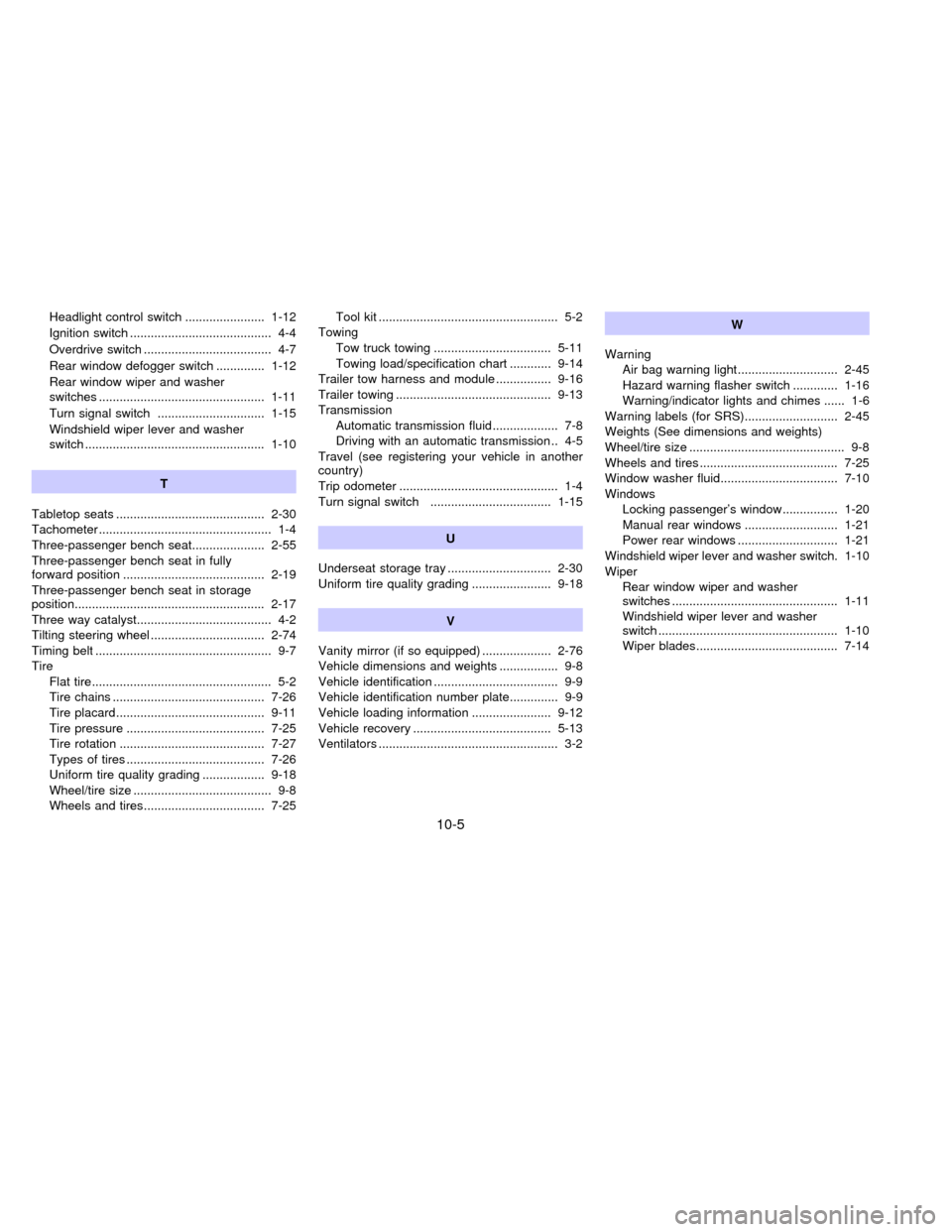
Headlight control switch ....................... 1-12
Ignition switch ......................................... 4-4
Overdrive switch ..................................... 4-7
Rear window defogger switch .............. 1-12
Rear window wiper and washer
switches ................................................ 1-11
Turn signal switch ............................... 1-15
Windshield wiper lever and washer
switch .................................................... 1-10
T
Tabletop seats ........................................... 2-30
Tachometer .................................................. 1-4
Three-passenger bench seat..................... 2-55
Three-passenger bench seat in fully
forward position ......................................... 2-19
Three-passenger bench seat in storage
position....................................................... 2-17
Three way catalyst....................................... 4-2
Tilting steering wheel ................................. 2-74
Timing belt ................................................... 9-7
Tire
Flat tire.................................................... 5-2
Tire chains ............................................ 7-26
Tire placard........................................... 9-11
Tire pressure ........................................ 7-25
Tire rotation .......................................... 7-27
Types of tires ........................................ 7-26
Uniform tire quality grading .................. 9-18
Wheel/tire size ........................................ 9-8
Wheels and tires................................... 7-25Tool kit .................................................... 5-2
Towing
Tow truck towing .................................. 5-11
Towing load/specification chart ............ 9-14
Trailer tow harness and module ................ 9-16
Trailer towing ............................................. 9-13
Transmission
Automatic transmission fluid ................... 7-8
Driving with an automatic transmission .. 4-5
Travel (see registering your vehicle in another
country)
Trip odometer .............................................. 1-4
Turn signal switch ................................... 1-15
U
Underseat storage tray .............................. 2-30
Uniform tire quality grading ....................... 9-18
V
Vanity mirror (if so equipped) .................... 2-76
Vehicle dimensions and weights ................. 9-8
Vehicle identification .................................... 9-9
Vehicle identification number plate.............. 9-9
Vehicle loading information ....................... 9-12
Vehicle recovery ........................................ 5-13
Ventilators .................................................... 3-2W
Warning
Air bag warning light............................. 2-45
Hazard warning flasher switch ............. 1-16
Warning/indicator lights and chimes ...... 1-6
Warning labels (for SRS)........................... 2-45
Weights (See dimensions and weights)
Wheel/tire size ............................................. 9-8
Wheels and tires ........................................ 7-25
Window washer fluid.................................. 7-10
Windows
Locking passenger's window ................ 1-20
Manual rear windows ........................... 1-21
Power rear windows ............................. 1-21
Windshield wiper lever and washer switch. 1-10
Wiper
Rear window wiper and washer
switches ................................................ 1-11
Windshield wiper lever and washer
switch .................................................... 1-10
Wiper blades......................................... 7-14
10-5
ZX